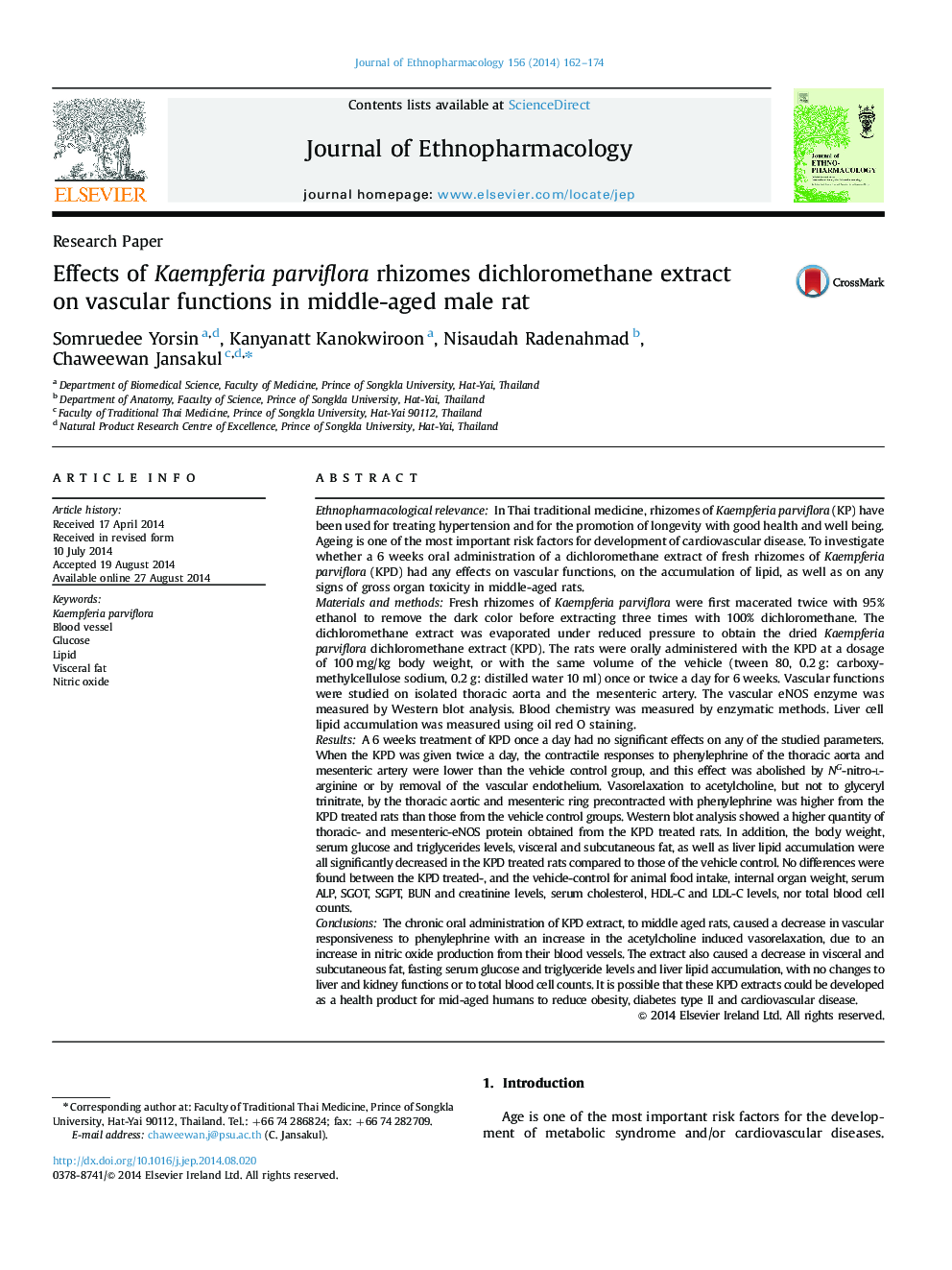| کد مقاله | کد نشریه | سال انتشار | مقاله انگلیسی | نسخه تمام متن |
|---|---|---|---|---|
| 2545253 | 1560405 | 2014 | 13 صفحه PDF | دانلود رایگان |
Ethnopharmacological relevanceIn Thai traditional medicine, rhizomes of Kaempferia parviflora (KP) have been used for treating hypertension and for the promotion of longevity with good health and well being. Ageing is one of the most important risk factors for development of cardiovascular disease. To investigate whether a 6 weeks oral administration of a dichloromethane extract of fresh rhizomes of Kaempferia parviflora (KPD) had any effects on vascular functions, on the accumulation of lipid, as well as on any signs of gross organ toxicity in middle-aged rats.Materials and methodsFresh rhizomes of Kaempferia parviflora were first macerated twice with 95% ethanol to remove the dark color before extracting three times with 100% dichloromethane. The dichloromethane extract was evaporated under reduced pressure to obtain the dried Kaempferia parviflora dichloromethane extract (KPD). The rats were orally administered with the KPD at a dosage of 100 mg/kg body weight, or with the same volume of the vehicle (tween 80, 0.2 g: carboxy-methylcellulose sodium, 0.2 g: distilled water 10 ml) once or twice a day for 6 weeks. Vascular functions were studied on isolated thoracic aorta and the mesenteric artery. The vascular eNOS enzyme was measured by Western blot analysis. Blood chemistry was measured by enzymatic methods. Liver cell lipid accumulation was measured using oil red O staining.ResultsA 6 weeks treatment of KPD once a day had no significant effects on any of the studied parameters. When the KPD was given twice a day, the contractile responses to phenylephrine of the thoracic aorta and mesenteric artery were lower than the vehicle control group, and this effect was abolished by NG-nitro-l-arginine or by removal of the vascular endothelium. Vasorelaxation to acetylcholine, but not to glyceryl trinitrate, by the thoracic aortic and mesenteric ring precontracted with phenylephrine was higher from the KPD treated rats than those from the vehicle control groups. Western blot analysis showed a higher quantity of thoracic- and mesenteric-eNOS protein obtained from the KPD treated rats. In addition, the body weight, serum glucose and triglycerides levels, visceral and subcutaneous fat, as well as liver lipid accumulation were all significantly decreased in the KPD treated rats compared to those of the vehicle control. No differences were found between the KPD treated-, and the vehicle-control for animal food intake, internal organ weight, serum ALP, SGOT, SGPT, BUN and creatinine levels, serum cholesterol, HDL-C and LDL-C levels, nor total blood cell counts.ConclusionsThe chronic oral administration of KPD extract, to middle aged rats, caused a decrease in vascular responsiveness to phenylephrine with an increase in the acetylcholine induced vasorelaxation, due to an increase in nitric oxide production from their blood vessels. The extract also caused a decrease in visceral and subcutaneous fat, fasting serum glucose and triglyceride levels and liver lipid accumulation, with no changes to liver and kidney functions or to total blood cell counts. It is possible that these KPD extracts could be developed as a health product for mid-aged humans to reduce obesity, diabetes type II and cardiovascular disease.
Figure optionsDownload high-quality image (262 K)Download as PowerPoint slide
Journal: Journal of Ethnopharmacology - Volume 156, 28 October 2014, Pages 162–174
